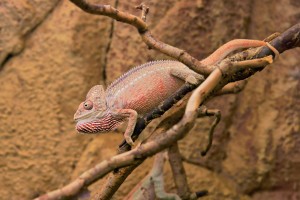 The Burmese python is notorious for being an invasive species slithering all over the Everglades, but there are many other invasive species living and breeding in the wetlands. In fact, there are around 139 species of reptiles and amphibians living in Florida, not to mention all the invasive mammals and plants! According to researchers at the University of Florida, there are more invasive species of reptiles and amphibians living in the wild in Florida than anywhere else in the world. Thanks to humans releasing their pets into the wild, there are now six different chameleon species in the wild in Florida. Chameleons are not native to Florida; they are an invasive reptile that hail from Africa, Madagascar, and parts of Asia and Europe.
The Burmese python is notorious for being an invasive species slithering all over the Everglades, but there are many other invasive species living and breeding in the wetlands. In fact, there are around 139 species of reptiles and amphibians living in Florida, not to mention all the invasive mammals and plants! According to researchers at the University of Florida, there are more invasive species of reptiles and amphibians living in the wild in Florida than anywhere else in the world. Thanks to humans releasing their pets into the wild, there are now six different chameleon species in the wild in Florida. Chameleons are not native to Florida; they are an invasive reptile that hail from Africa, Madagascar, and parts of Asia and Europe.
Unlike the Burmese python, chameleons aren’t as dangerous of a creature and are not having a drastic negative impact on the ecosystem of Florida or the Everglades; they are not a top priority for the Florida Fish and Wildlife Conservation Commission. However, they do prey on insects, small frogs, lizards, small mammals and birds. They are known to eat a lot of pests like stinkbugs, caterpillars, geckos and weevils, but scientists are afraid they will begin to eat more native species.
Chameleons, like the Oustalet chameleon, are known to have a high reproductive rate and can thrive in many different environments, including forests and agricultural land. This particular kind of chameleon can grow up to 24 inches long; the male Oustalets are a tan color with brown and black stripes while the females are green with white dotes. Another chameleon found in Florida is the veiled chameleon; this chameleon is native to the Arabian Peninsula. They range in size from 1 to 2 feet; the males are green with bands of yellow with blue, orange, or black and the females are green with white, orange or yellow spots.
These breeds, along with the other breeds of chameleons, have been found in Miami-Dade, Broward, Lee, Collier counties, as well as other areas of Florida.
Just like with the pythons, there are groups of people that head out into the Florida wilderness to hunt for these chameleons. These hunters are known as “herpers” who catch invasive chameleons in rural and residential areas, and will adopt or sell them. They head out at night and shine flashlights into trees to spot these reptiles. It’s easier to find chameleons at night; since they can change their skin color, they aren’t so easy to find during daylight hours.
These herpers gather in online forums to share popular hiding spots for chameleons and tips on how to find and catch them. “Ranchers” are also out there; ranchers breed and raise the chameleons they find to sell them; this is considered to be a controversial activity. The panther chameleon, which is roaming in rural spots of Florida, can sell for up to $1,000.
All of the species of chameleons in Florida where brought to the United States in the pet trade. Because they are not native, it is OK to take them out of the trees and flora in Florida; they are not protected here. However, if someone catches one, he or she cannot put it back, since it’s illegal to release them into the wild.
If you spot one in the Everglades or other area of Florida, take a photo, write down the location and report your siting to IveGot1.org or download the IveGot1 app.
Interested in spending some time in the Everglades among all the varied species? A great and safe way to explore is on an airboat tour. You’ll see an array of sights and sounds right from the airboat. To book an airboat ride, contact Captain Mitch’s Airboat Tours at 800-368-0065 or click here.






